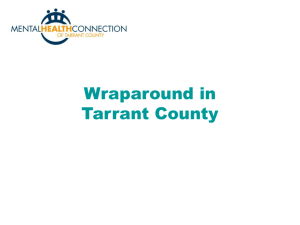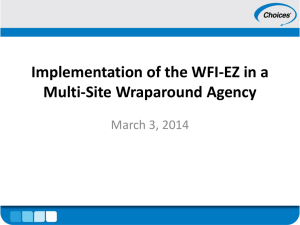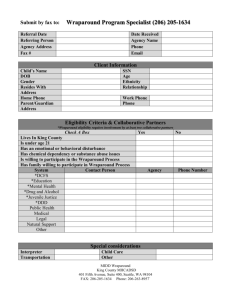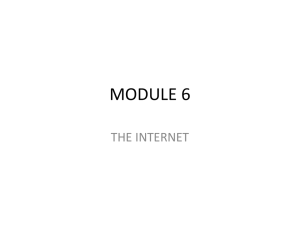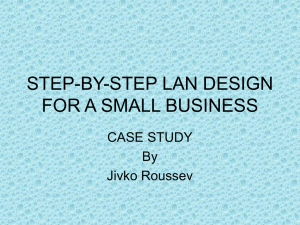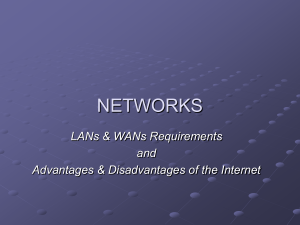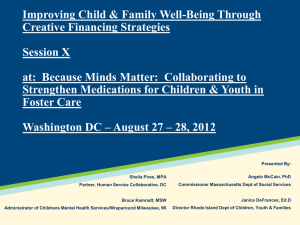LOCAL AREA NETWORKs (LANs
advertisement
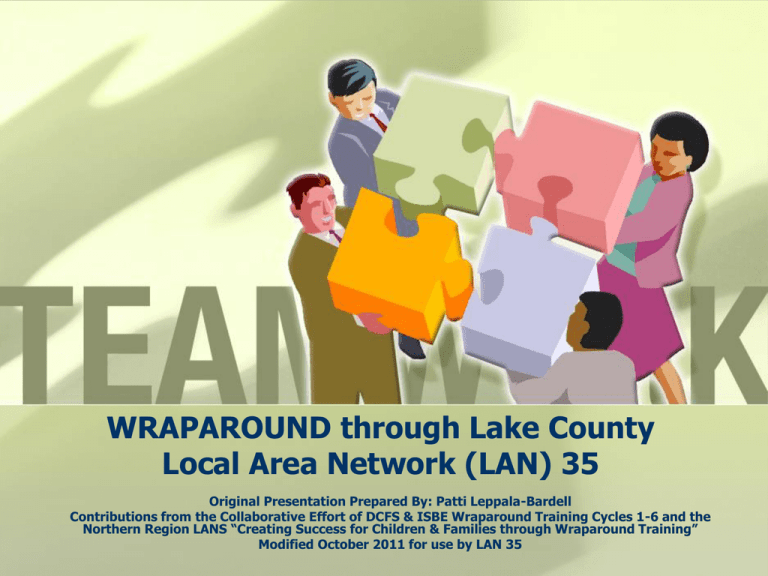
WRAPAROUND through Lake County Local Area Network (LAN) 35 Original Presentation Prepared By: Patti Leppala-Bardell Contributions from the Collaborative Effort of DCFS & ISBE Wraparound Training Cycles 1-6 and the Northern Region LANS “Creating Success for Children & Families through Wraparound Training” Modified October 2011 for use by LAN 35 Training Goals Gain a clear understanding of the Wraparound Process Learn what a LAN is and how it is connected to the Wraparound Process Develop an understanding of the role of the Wraparound Facilitator and others on the Child and Family Team Understand process for identification of strengths & needs Gain an understanding of Lake County LAN 35 wraparound presentation process Provide contact information & forms for presentation to the Lake County LAN 35 Wraparound is a process Wraparound is not something you “get”…. It’s something you do Historical Overview – Wraparound The Beginning of “Wraparound” John Brown and colleagues in Canada developed programs that were needs-based, unconditional and provided individualized services. 1975 In the U.S., the process began to be used at Kaleidoscope in Chicago, led by Karl Dennis, and was referred to as “individualized services”. (Focal Point, 2003) Historical Overview of Wraparound (cont.) 1980’s Wraparound term was coined in early 80’s by Dr. Lenore Behar of North Carolina 1985 Alaska officials sought consultation from Kaleidoscope (Illinois) and formed the Alaska Youth Initiative. Alaska’s efforts were replicated quickly by Washington, Vermont and 30 other states. (Focal Point, 2003) Historical Overview – Wraparound in Illinois 1987 The Community and Residential Services Authority (CRSA) initiated interagency discussions regarding reform of the way state agencies provided services to families. 1991 ISBE began to redirect educational dollars spent on residential placements to communitybased project sites. Historical Overview – Wraparound in Illinois (cont.) 1991 ISBE also started to utilize the wraparound process. 1993 Four state agencies (DHS MH/DD, DCFS, DASA, and ISBE) issued a joint letter announcing that they were ready to proceed with the development of statewide Child & Adolescent Local Area Networks (C&A LANs). Historical Overview – Wraparound in Illinois (cont.) 1993-1994 Local Area Networks (LANs) were established with geographical boundaries creating 62 LANs across Illinois. 1994 The Department of Children and Family Services committed to utilizing LANs as its local infrastructure to plan, develop and manage services to respond to the real needs of youth and families in their communities. Present The 62 Illinois LANS continue to operate through contributions from DCFS & ISBE What is a LAN? LAN is the acronym for Local Area Network. LANs are voluntary, community based networks in geographically designated areas of Illinois. The networks seek to bring together stakeholders who have an interest in the welfare of youth and families to plan together to improve service delivery. Why Have LANs? Better use of school/community based resources Changes focus from negative approach to building upon positive behaviors Increases community coordination & collaboration Provides flexible, individualized approach to helping students and their families Contains costs and demonstrates cost effectiveness LAN funding sources DCFS Family Centered Services ISBE Flexible Funds IDEA Discretionary Funds (Flex Funds) 62 Illinois LANs Cook County LANs How is a LAN connected to Wraparound? Each LAN has a Wraparound Committee that approves Flexible Funding for individual Wraparound Plans and budgets. LAN generally offers additional ideas or suggestions to the Child & Family Team for blending programs and funds, and accessing resources. LAN funds are time-limited & capped. And what is Wraparound? “The approach is really very simple. It is what you would do for youth and families if you really liked them and if you were given the tools that would allow you not to give up on them. It is what you would do if you could break free from the constraints that our professional training and agency structures place upon our desire to do what makes sense.” Quote from Karl Dennis of Kaleidoscope, Inc. Wraparound Values Builds on strengths to meet needs One family, one plan Increased parent choice Increased family independence Care for youth in context of families Care for families in context of community Never give up approach Who can be referred to LAN 35 (Lake County LAN)? Any youth in Lake County Illinois, ages 3-21, at risk of, or experiencing, truancy, suspensions, and/or expulsion from school Any youth at risk of educational failure due to behavioral and/or academic issues. ISBE goal is “to improve educational outcomes.” *Any child can benefit from the wraparound process. Step 1: Child & Family Team A good professional team member should…… “check your title at the door but bring your expertise to the table.” Members: Youth, Adult Caregiver, Facilitator, Formal Supports & Informal Supports The Team Natural/Informal “Family” members Neighbors and friends Church Members Other people that the “family” is regularly in contact with Professional/Formal School Personnel Counselors Child Welfare Caseworkers Others Sample Team School Therapist Faith Based Support Facilitator Child and Family Friends and Neighbors Mentor Caregiver/ Biological Parent Social Service Personnel The Facilitator Facilitate: to make easier or less difficult; help forward (an action, a process, etc.): to assist the progress of (a person). Facilitator may be the school social worker, therapist, community casemanager, mentor, ICG worker, post-adoption worker or any other person identified as the person who will lead the process. Facilitator Responsibilities Organize the Team Facilitate Child & Family Team Meetings Document the Plan Explore community based resources Identify costs for requested services Manage the Team and Plan over Time Complete follow-up until plan’s closing Step 2: Develop Mission Statement Mission Statement is the family’s view of a better life. “What are our plans & goals?” Normalization Futuring Goal statements are based on life, not treatment. Step 3: Identify Strengths All people have strengths, unique to them. Strengths are the things that pull people through the hard times. Change is supported by building on strengths. Functional Strengths What can the family do? What are their problem solving skills? How have those skills worked for them? Listening for Strengths Traits & Talents--Who is the youth/family & what are their characteristics? Skills and Abilities--What can the youth/family do? Attributes and History--Who was involved, and what did they contribute? Preferences--What else would feel real and valid for this youth/family? Step 4: Identify Needs by Life Domain Don’t assume you know what’s best. Needs are not services; Services are often the way we meet the need. Examine needs through each life domain. Change begins when people feel respected & supported. Avoid hidden agendas. Life Domain Areas Family/Attachment Physical Needs/Living Situation Safety Educational/Vocational Cultural/Spiritual Health Emotional/Psychological Socialization Legal Points to consider by domain: physical/living Physical needs/living situation: basic needs such as food, shelter with adequate utilities, space and furniture. Being free of physical hazards for self and others. Examples: Need a place to feel safe, need a place to keep possessions, need a place where heat and water are reliably provided, and need for nutritional nourishment. Need for separate bedrooms for youths & adults, need for adequate security/locks and need to reside in a structurally sound place. Points to consider: cultural/spiritual Cultural/Spiritual: beliefs, customs, arts & institutions of a particular society and/or organized religion and takes into consideration ethnicity, race, gender, age, and sexual orientation. Examples: Need to maintain connections, or reconnect, with people of own’s race, religion, language or other aspect of culture, need for emotional support and understanding from others of the same sexual orientation Points to consider: family Family: Who is in the family? What are the roles and responsibilities to one another in relation to the family structure? Broad definition of family--includes other individuals outside of blood relations. Examples: Need for access among family members, need for clear definition of adult role and child role, need to function in a manner that benefits the entire family. Points to consider: educational/vocational Educational/Vocational: process of learning and how and where people learn and/or acquire skills for employment Need specific ways of learning or understanding material, need assistance with homework, need to learn job skills, and need to graduate from school Points to consider: health/medical Health/Medical: Any physical or medical conditions that may exist within the family Need for certain medications or procedures, need for certain ongoing medical treatments, and a need for regular health maintenance. Need to take medications as prescribed at school. Points to consider: safety Safety: Issues relating to the need for safety for the youth and family and in the community at large; identification of need for crisis planning Need to feel and be safe, need to be in an environment that provides some degree of safety; need to have plan to achieve safety Points to consider: social/recreational Social and Recreational: Addresses the interrelationship of people in society as well as the need to engage in leisurely pursuits in order to refresh and relax oneself. Need for communication, need to relate to others in a way that is valued and respected, and need to create a positive daily routine and environment. Continued.. Need to engage in physical activity, need to occupy time in a constructive manner, and the need to pursue activities that are pleasurable and soothing. Need for, and ability to, interact with others in productive and positive ways. Need to have fun as an individual and family. Need access to appropriate resources. Need to have friends at school in structured and unstructured settings. Points to consider: legal Legal: Relates to matters of the law or legal system and its functions Need for definition of legal custody, need for court protection, need for legal representation, and need to complete terms of specific court obligations Step 5: Prioritize Needs Using family voice and perspective, the team selects the most important needs to work on during the coming time frame. Identify possible resources/services to meet needs. Identify Costs for requested services Present case to the wraparound council for brainstorming, if needed. Step 6: Develop Action Strategies & Assign Tasks The team should: Brainstorm strategies that will help the family move forward. Recommend service linkages. Research costs. Ensure action strategies are tied to the strengths of the family & support the mission statement. Assign tasks, time frames and specific follow-up activities. Step 7: Document the Plan Document the plan on the applicable form for the LAN. (Note: each LAN may have unique forms) Develop a mechanism for evaluating if it is working and plan to change it as necessary. Determine strategies for transition from formal supports toward informal, responsive supports over time. (Remember, wraparound supports are time-limited.) Step 8: Present Wrap Plan to Screening Committee Schedule an appointment with the LAN coconvener. Bring original plan SIGNED by parent/guardian AND child, if child is over age of 12 Be prepared to answer questions about the family and the plan LAN Screening Committee will vote on the plan Facilitator will notify providers of approvals and/or next steps. Lake County LAN 35 mtgs The Lake County LAN 35 meets every first Thursday of the month. The LAN Steering Committee meets from 9-10 a.m. for business agenda and resource sharing. The LAN Screening Committee hears cases following the business meeting, beginning at 10 a.m. Meetings for January, March, April, June, July, September & October are held at Allendale’s Bradley Counseling Center, located at 450 W. Grand Avenue, Lake Villa, IL, Meetings for February, May, August and November are held in the large conference area first floor, Vista Medical Center at 2615 Washington Street, Waukegan, IL 60085 Brainstorming Cases can be presented to the wraparound council to assist with identification of possible services, supports, and linkages in advance of formal presentation of the plan. If identifying information is to be shared, written release from the parent and youth for such exchange of information should be provided. Please note that summer camp requests should be submitted by April each year. The Presentation To present a case to the Wraparound Council, the team facilitator should contact Merlean Lovelady at 847-362-2111 to obtain a time for the agenda. (Note:If the parent and/or youth will be attending the presentation, please indicate so when calling.) The facilitator has 10 minutes reserved to present the case needs, including a brief summary of the family history, strengths, and needs. The plan and the “Application for Flex Funds” page should be thoroughly completed with specifics of agency, cost and service type requested. The Budget Services/Goods can be approved only for 90 days per request. Caps exist. Copies of overdue bills should accompany any requests for payment. Inquiries should be made to agencies in advance of council presentation to explore possible scholarship or reduced fee options. Checks should be made out to providers whose names are listed on the approved Application for Flex Funds form. Providers must provide receipts. Follow-up The facilitator is responsible for providing follow-up on each case presented. (Refer to follow-up form.) Follow-ups should occur no later than 90 days after approval is granted. Follow-ups should be presented in person. Lake County LAN Wraparound Forms Authorization for Release of Information Wraparound Plan Child & Family Team Member Signature Sheet Application for Flexible Funds Follow-Up Form Lake Co. LAN 35 Contacts For questions about a LAN 35 case, please contact: Co-Convener Linda Amundsen 847-986-2325 Co-Convener Sali Martin 847-838-0680 Julie Pettinato Lake Co Health Dept 847-377-8965 Judy Griffeth Allendale 847-245-6330 Or please visit our LAN 35 blog at: http://lakecountylan35.wordpress.com Statewide Contacts DCFS LAN Liaison LANs 34, 35, 47 Phil Biage Phone: 630-801-3480 Email: Phillip.Biage@illinois.gov Community & Residential Services Authority (CRSA) Jude Deangelo Phone: 877-541-2772 Email: Jude.deangelo@illinois.gov Questions?
